Discrete-Ordinates Modelling of the Radiative Heat Transfer in a Pilot-Scale Rotary Kiln
Abstract
1. Introduction
2. Methodology
2.1. Modelling
2.2. Data Gathering and Usage
3. Results and Discussion
4. Conclusions
Author Contributions
Funding
Acknowledgments
Conflicts of Interest
Nomenclature
| cell area in radial direction | polar angle | ||
| cell area in angular direction | cell angle | ||
| cell area in axial direction | absorption coefficient | ||
| unit vectors in Cartesian coordinates | wave number | ||
| radiative intensity | Stefan-Boltzmann constant | ||
| cell type | scattering coefficient | ||
| cell type | scattering phase function | ||
| conductive heat transfer coefficient | azimuthal angle | ||
| furnace length | space variable | ||
| number of cells | solid angle | ||
| total number of directions used | |||
| Nusselt number | Subscripts | ||
| radius | black body | ||
| Prandtl number | conductive heat transfer | ||
| heat transfer | furnace diameter | ||
| radiative heat flux | radial position | ||
| Rayleigh number | angular position | ||
| unit vector in a given direction | axial position | ||
| temperature | discrete direction | ||
| cell volume | outer | ||
| angular quadrature weight | node point | ||
| radial cell | |||
| Greek Symbols | wall | ||
| angular derivative coefficient | axial cell | ||
| cell angle | ambient | ||
| emissivity | |||
| direction cosine | |||
References
- Boateng, A.A. Rotary Kilns Transport. Phenomena and Transport. Processes; Butterworth-Heinmann: Oxford, UK, 2008. [Google Scholar]
- Cross, M.; Young, R.W. Mathematical model of rotary kilns used in the production of iron ore pellets. Ironmak. Steelmak. 1976, 3, 129–137. [Google Scholar]
- Gorog, J.P.; Brimacombe, J.K.; Adams, T.N. Radiative heat transfer in rotary kilns. Met. Trans. B 1981, 12, 55–70. [Google Scholar] [CrossRef]
- Gorog, J.P.; Adams, T.N.; Brimacombe, J.K. Regenerative Heat Transfer in Rotary Kilns. Met. Trans. B 1982, 13, 153–163. [Google Scholar] [CrossRef]
- Gorog, J.P.; Adams, T.N.; Brimacombe, J.K. Heat Transfer from Flames in a Rotary Kiln. Met. Trans. B 1983, 14, 411–424. [Google Scholar] [CrossRef]
- Thornton, G.J.; Batterham, R.J. The Transfer of Heat in Kilns. In Proceedings of the Tenth Australian Chemical Engineering Conference, Sydney, Australia, 24–26 August 1982; pp. 260–266. [Google Scholar]
- Barr, P.V.; Brimacombe, J.K.; Watkinson, A.P. A Heat-Transfer Model for the Rotary Kiln: Part I. Pilot Kiln Trials. Met. Mater. Trans. B 1989, 20, 391–402. [Google Scholar] [CrossRef]
- Barr, P.V.; Brimacombe, J.K.; Watkinson, A.P. A heat transfer model for the rotary kiln: Part II. Development of the cross section model. Met. Mater. Trans. B 1989, 20, 403–419. [Google Scholar] [CrossRef]
- Boateng, A.A.; Barr, P.V. A thermal model for the rotary kiln including heat transfer within the bed. Int. J. Heat Mass Transf. 1996, 39, 2131–2147. [Google Scholar] [CrossRef]
- Herz, F.; Mitov, I.; Specht, E.; Stanev, R. Influence of the Motion Behavior on the Contact Heat Transfer Between the Covered Wall and Solid Bed in Rotary Kilns. Exp. Heat Transf. 2015, 28, 174–188. [Google Scholar] [CrossRef]
- Wes, G.W.J.; Drinkenburg, A.A.H.; Stemerding, S. Heat Transfer in a Horizontal Rotary Drum Reactor. Powder Technol. 1976, 13, 185–192. [Google Scholar] [CrossRef]
- Li, S.Q.; Ma, L.B.; Wan, W.; Yao, Q. A mathematical model of heat transfer in a rotary kiln thermo-reactor. Chem. Eng. Technol. 2005, 28, 1480–1489. [Google Scholar] [CrossRef]
- Njeng, S.A.B.; Vitu, S.; Clausse, M.; Dirion, J.; Debacq, M. Wall-to-solid heat transfer coefficient in flighted rotary kilns: Experimental determination and modeling. Exp. Ther. Fluid Sci. 2018, 91, 197–213. [Google Scholar] [CrossRef]
- Tscheng, S.H.; Watkinson, A.P. Convective Heat Transfer in a Rotary Kiln. Can. J. Chem. Eng. 1979, 57, 433–443. [Google Scholar] [CrossRef]
- Specht, E. Heat and Mass Transfer in Thermoprocessing; Vulkan Verlag GmbH: Essen, Germany, 2017. [Google Scholar]
- Georgallis, M.; Nowak, P.; Salcudean, M.; Gartshore, I.S. Modelling the Rotary Lime Kiln. Can. J. Chem. Eng. 2008, 83, 212–223. [Google Scholar] [CrossRef]
- Mujumdar, K.S.; Ranade, V.V. CFD modeling of rotary cement kilns. Asia-Pac. J. Chem. Eng. 2008, 3, 106–118. [Google Scholar]
- Mouangue, R.; Ngako, S.; Tégawendé Zaida, J.; Kuitche, A. Heavy Fuel Oil Combustion in a Cement Rotary Kiln: Measurement and Modelling. Ind. Combust. J. Int. Flame Res. Found. 2020, 1–29. [Google Scholar]
- Witt, P.J.; Sinnott, M.D.; Cleary, P.W.; Schwarz, M.P. A hierarchical simulation methodology for rotary kilns including granular fl ow and heat transfer. Min. Eng. 2018, 119, 244–262. [Google Scholar] [CrossRef]
- Forsmo, S.P.E.; Forsmo, S.-E.; Samskog, P.-O.; Björkman, B.M.T. Mechanisms in oxidation and sintering of magnetite iron ore green pellets. Powder Technol. 2008, 183, 247–259. [Google Scholar] [CrossRef]
- Jonsson, C.Y.C.; Stjernberg, J.; Wiinikka, H.; Lindblom, B.; Boström, D.; Öhman, M. Deposit formation in a grate-kiln plant for iron-ore pellet production. Part 1: Characterization process gas particles. Energy Fuels 2013, 27, 6159–6170. [Google Scholar] [CrossRef]
- Carlson, B.G.; Lathrop, K.D. Transport Theory The Method of Discrete Ordinates. In Computing Methods in Reactor Physics; Greenspan, H., Kelber, C.N., Okrent, D., Eds.; Gordon and Breach Science Publishers: New York, NY, USA, 1968; pp. 171–265. [Google Scholar]
- Coelho, P.J. Advances in the discrete ordinates and finite volume methods for the solution of radiative heat transfer problems in participating media. J. Quant. Spectrosc. Radiat. Transf. 2014, 145, 121–146. [Google Scholar] [CrossRef]
- Jamaluddin, A.S.; Smith, P.J. Predicting Radiative Transfer in Axisymmetric Cylindrical Enclosures Using the Discrete Ordinates Method. Combust. Sci. Technol. 1988, 62, 173–186. [Google Scholar] [CrossRef]
- Jamaluddin, A.S.; Smith, P.J. Discrete-Ordinates Solution of Radiative Transfer Equation in Nonaxisymmetric Cylindrical Enclosures. J. Ther. Heat Transf. 1992, 6, 242–245. [Google Scholar] [CrossRef]
- Kim, M.Y.; Baek, S.W. Modeling of radiative heat transfer in an axisymmetric cylindrical enclosure with participating medium. J. Quant. Spectrosc. Radiat. Transf. 2005, 90, 377–388. [Google Scholar] [CrossRef]
- Adams, B.R.; Smith, P.J. Three dimensional discrete ordinates modelling of Radiative transfer in a geometrically complex furnace. Combust. Sci. Technol. 1993, 88, 293–308. [Google Scholar] [CrossRef]
- Byun, D.Y.; Baek, S.W.; Kim, M.Y. Investigation of Radiative Heat Transfer in Complex Geometries Using Blocked-Off, Multiblock, and Embedded Boundary Treatments. Numer. Heat Transf. 2003, 43, 807–825. [Google Scholar] [CrossRef]
- Seo, S.-H.; Kim, T.-K. Study on Interpolation Schemes of the Discrete Ordinates Interpolation Method for Three-Dimensional Radiative Heat Transfer with Nonorthogonal Grids. J. Heat Transf. 1998, 120, 1091–1094. [Google Scholar] [CrossRef]
- Howell, L.H.; Beckner, V.E. A Discrete Ordinates Algorithm for Domains with Embedded Boundaries. J. Ther. Heat Transf. 1997, 11, 549–555. [Google Scholar] [CrossRef][Green Version]
- Liu, J.; Shang, H.M.; Chen, Y.S.; Wang, T.S. Prediction of Radiative Transfer in General Body-Fitted Coordinates. Numer. Heat Transf. 1997, 31, 423–439. [Google Scholar] [CrossRef]
- Gunnarsson, A.; Andersson, K.; Adams, B.R.; Fredriksson, C. Full-scale 3D-modelling of the radiative heat transfer in rotary kilns with a present bed material. Int. J. Heat Mass Transf. 2019, 147. [Google Scholar] [CrossRef]
- Gunnarsson, A.; Andersson, K.; Bradley, A. 3D-Modelling of the Radiative Heat Transfer in Rotary Kilns with a Present Bed Material. In Proceedings of the 6th International Conference on Computational Thermal Radiation in Participating Media, Cascais, Portugal, 11–13 April 2018. [Google Scholar]
- Gunnarsson, A.; Bäckström, D.; Johansson, R.; Fredriksson, C.; Andersson, K. Radiative Heat Transfer Conditions in a Rotary Kiln Test Furnace Using Coal, Biomass, and Cofiring Burners. Energy Fuels 2017, 31, 7482–7492. [Google Scholar] [CrossRef]
- Bäckström, D.; Johansson, R.; Andersson, K.; Wiinikka, H.; Fredriksson, C. On the use of alternative fuels in rotary kiln burners—An experimental and modelling study of the effect on the radiative heat transfer conditions. Fuel Process. Technol. 2015, 138, 210–220. [Google Scholar] [CrossRef]
- Modest, M.F. Radiative Heat Transfer, 3rd ed.; Elsevier: Amsterdam, The Netherlands, 2013. [Google Scholar]
- Fiveland, W.A. Three-Dimensional Radiative Heat-Transfer Solutions by the Discrete-Ordinates Method. J. Ther. Heat Transf. 1988, 2, 309–316. [Google Scholar] [CrossRef]
- Liu, J.; Shang, H.M.; Chen, Y.S. Development of an unstructured radiation model applicable for two-dimensional planar, axisymmetric, and three-dimensional geometries. J. Quant. Spectrosc. Radiat. Transf. 2000, 66, 17–33. [Google Scholar] [CrossRef]
- Hottel, H.C.; Sarofim, A.F. Radiative Transfer, 1st ed.; McGraw-Hill, Inc.: New York, NY, USA, 1967. [Google Scholar]
- Johansson, R.; Leckner, B.; Andersson, K.; Johnsson, F. Account for variations in the H2O to CO2 molar ratio when modelling gaseous radiative heat transfer with the weighted-sum-of-grey-gases model. Combust. Flame 2011, 158, 893–901. [Google Scholar] [CrossRef]
- Foster, P.J.; Howarth, C.R. Optical Constants of Carbons and Coals in the Infrared. Carbon 1968, 6, 719–729. [Google Scholar] [CrossRef]
- Lohi, A.; Wynnyckyj, J.R.; Rhodes, E. Spectral measurement of the complex refractive index of fly ashes of canadian lignite and sub-bituminous coals. Can. J. Chem. Eng. 1992, 70, 751–758. [Google Scholar] [CrossRef]
- Gupta, R.P.; Wall, T.F. The optical properties of fly ash in coal fired furnaces. Combust. Flame 1985, 61, 145–151. [Google Scholar] [CrossRef]
- Goodwin, D.G.; Mitchner, M. Flyash Radiative Properties and Effects on Radiative Heat-Transfer in Coal-fired Systems. Int. J. Heat Mass Transf. 1989, 32, 627–638. [Google Scholar] [CrossRef]
- Chang, H.; Charalampopoulos, T.T. Determination of the Wavelength Dependence of Refractive Indices of Flame Soot. Proc. R. Soc. A Math. Phys. Eng. Sci. 1990, 430, 577–591. [Google Scholar] [CrossRef]
- Gronarz, T.; Schulze, J.; Laemmerhold, M.; Graeser, P.; Gorewoda, J.; Kez, V.; Habermehl, M.; Schiemann, M.; Ströhle, J.; Epple, B.; et al. Quantification of the influence of parameters determining radiative heat transfer in an oxy-fuel operated boiler. Fuel Process. Technol. 2017, 157, 76–89. [Google Scholar] [CrossRef]
- Yu, M.J.; Baek, S.W.; Kang, S.J.A.E. Modeling of Pulverized Coal Combustion with Non- Gray Gas Radiation Effects. Combust. Sci. Technol. 2001, 166, 151–174. [Google Scholar] [CrossRef]
- Modest, M.F. The Method of Discrete Ordinates (SN-Approximation). In Radiative Heat Transfer, 3rd ed.; Elsevier: Amsterdam, The Netherlands, 2013; pp. 541–584. [Google Scholar]
- Churchill, S.W.; Chu, H.H.S. Correlating Equations for Laminar and Turbulent Free Convection from a Horizontal Cylinder. Int. J. Heat Mass Transf. 1975, 18, 1049–1053. [Google Scholar] [CrossRef]
- Incropera, F.P.; Dewitt, D.P.; Bergman, T.L.; Lavine, A.S. Free Convection. In Principles of Heat and Mass Trasnfer; John Wiley & Sons, Inc.: Hoboken, NJ, USA, 2013; pp. 594–652. [Google Scholar]
- Weber, R. Scaling characteristics of aerodynamics, heat transfer, and pollutant emissions in industrial flames. Symp. Combust. 1996, 26, 3343–3354. [Google Scholar] [CrossRef]
- Edland, R.; Normann, F.; Fredriksson, C.; Andersson, K. Implications of Fuel Choice and Burner Settings for Combustion Efficiency and NO x Formation in PF-Fired Iron Ore Rotary Kilns. Energy Fuels 2017, 31, 3253–3261. [Google Scholar] [CrossRef]
- Im, K.H.; Ahluwalia, R.K. Radiation properties of coal combustion products. Int. J. Heat Mass Transf. 1993, 36, 293–302. [Google Scholar] [CrossRef]

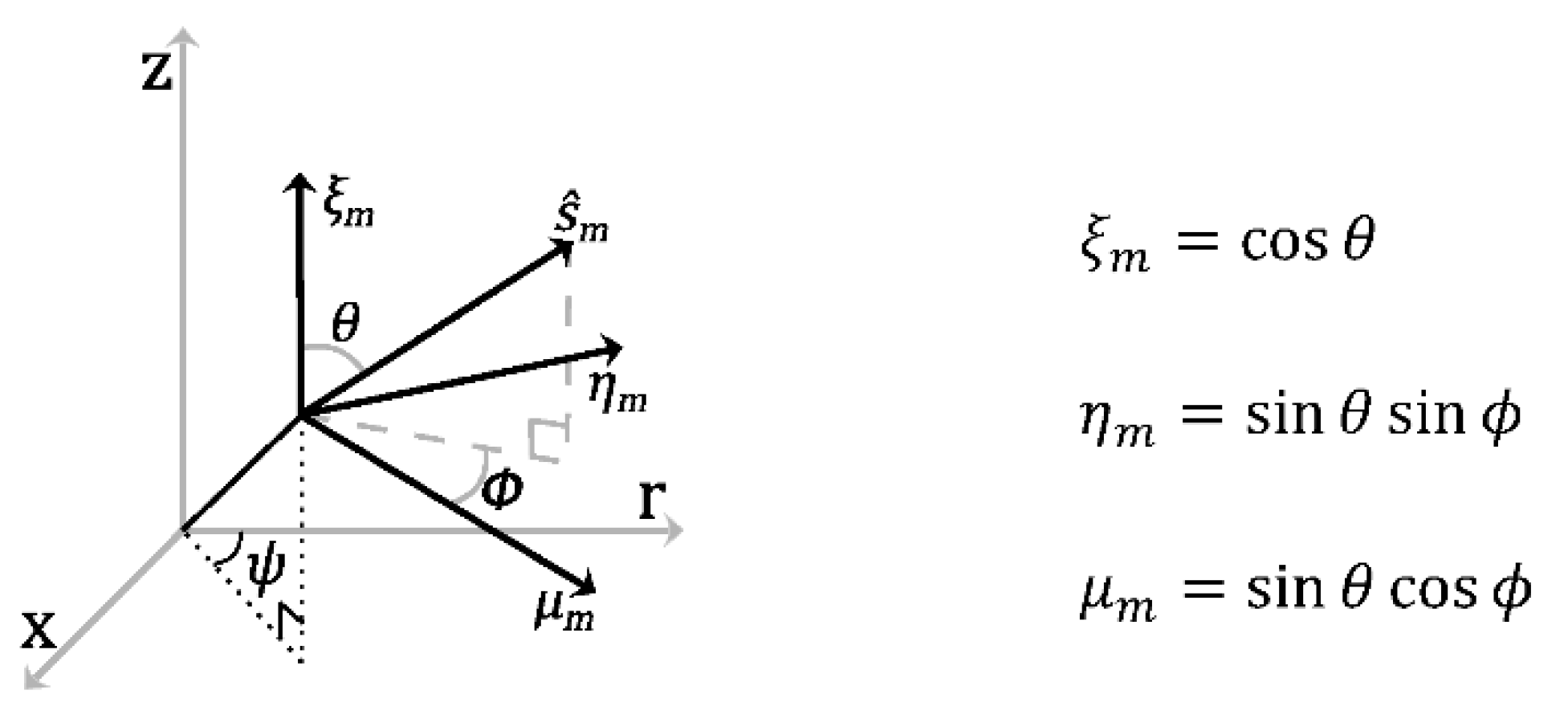
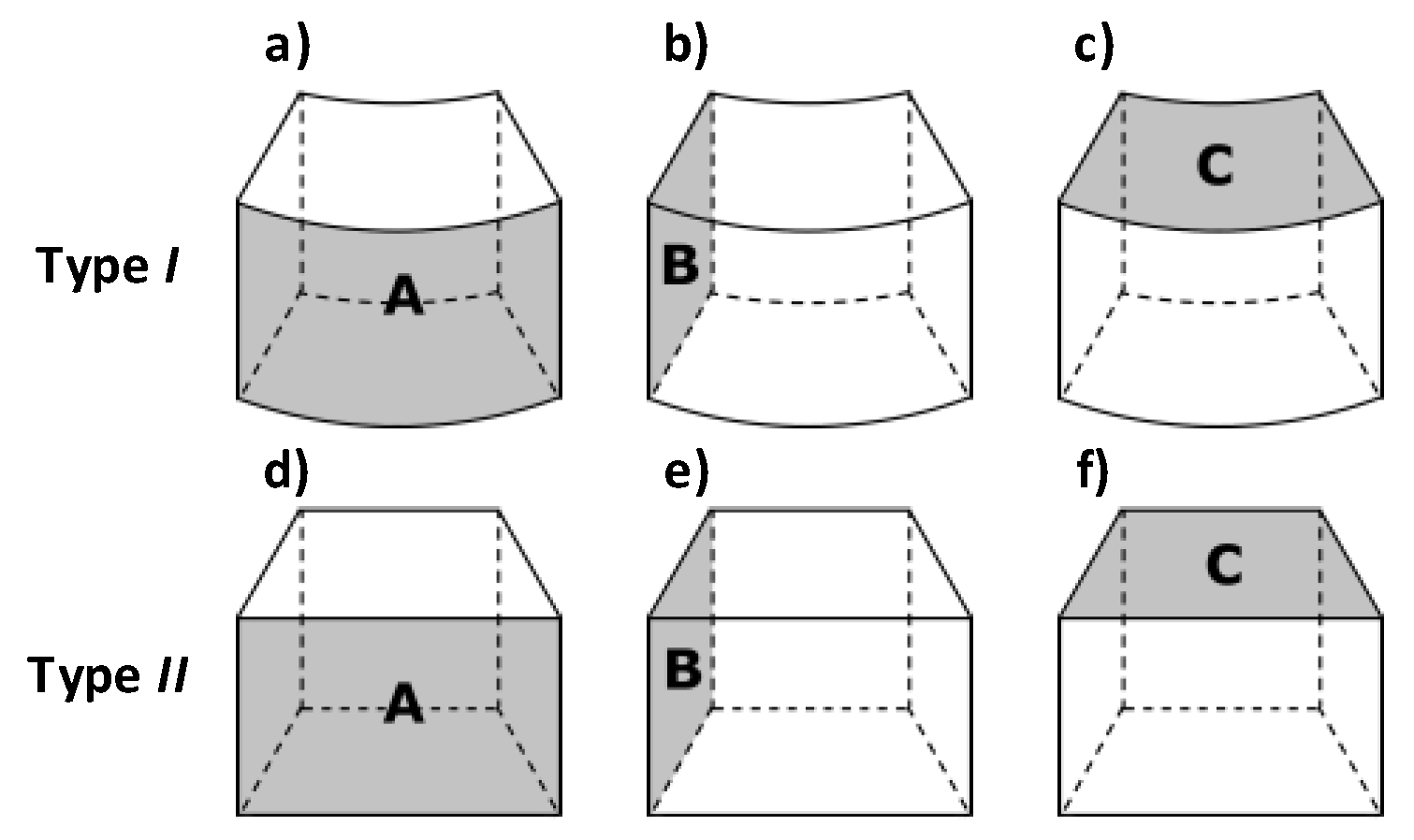
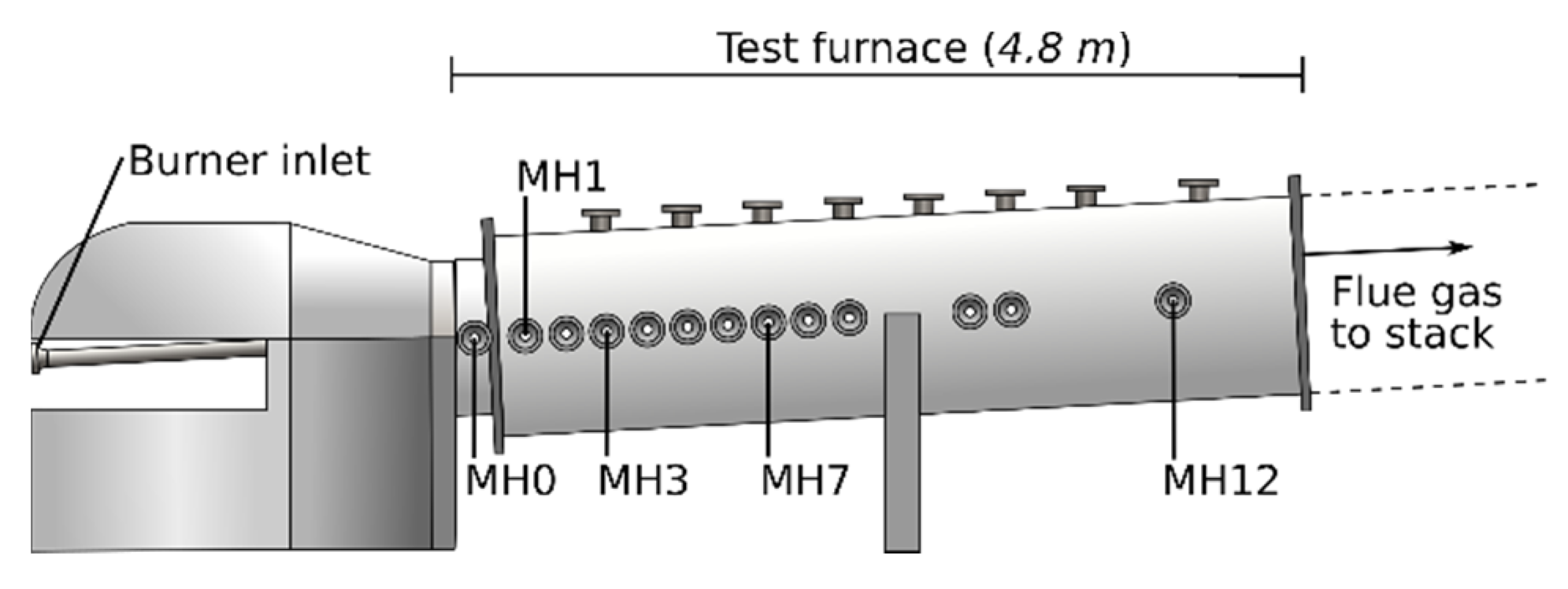
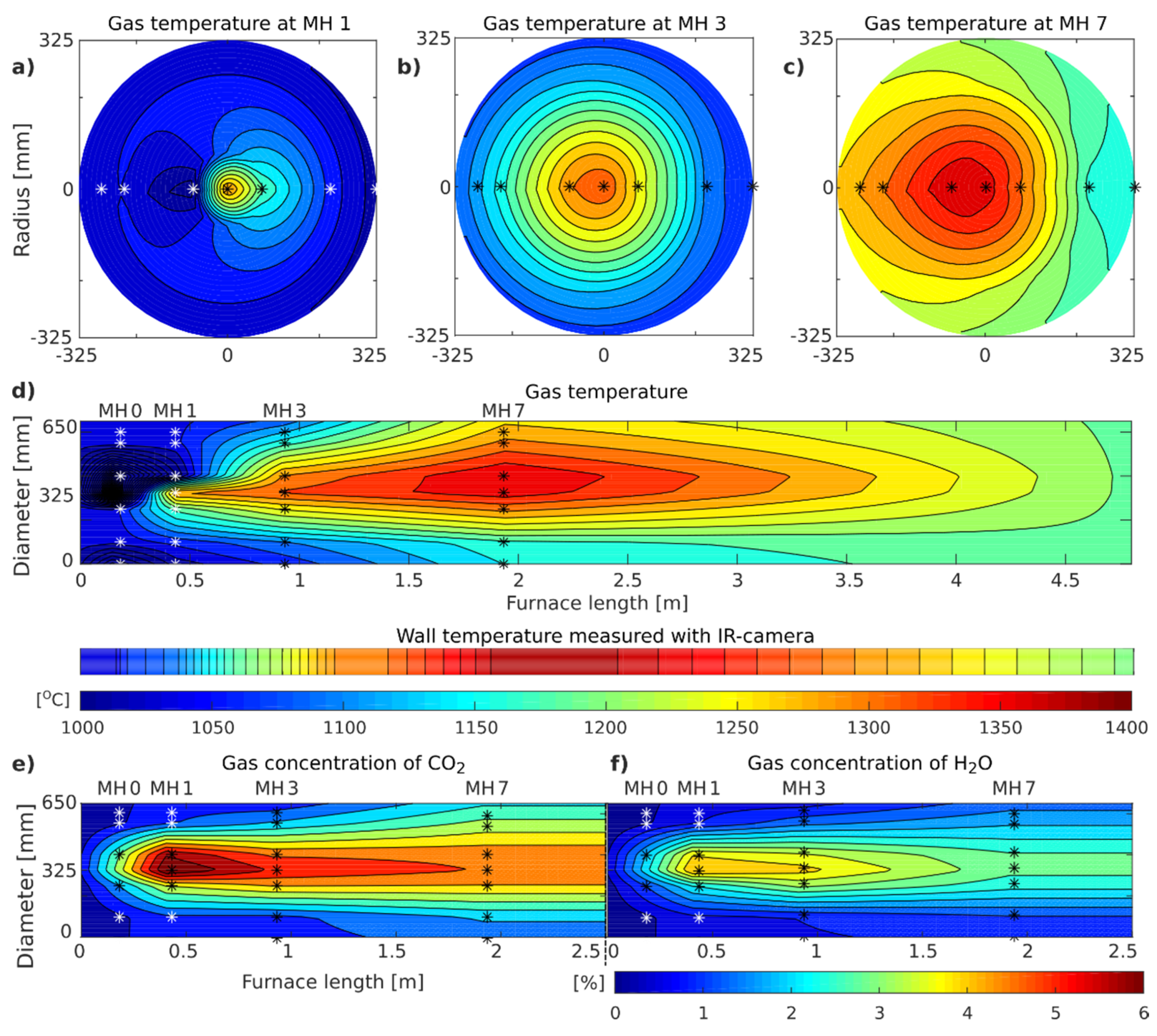
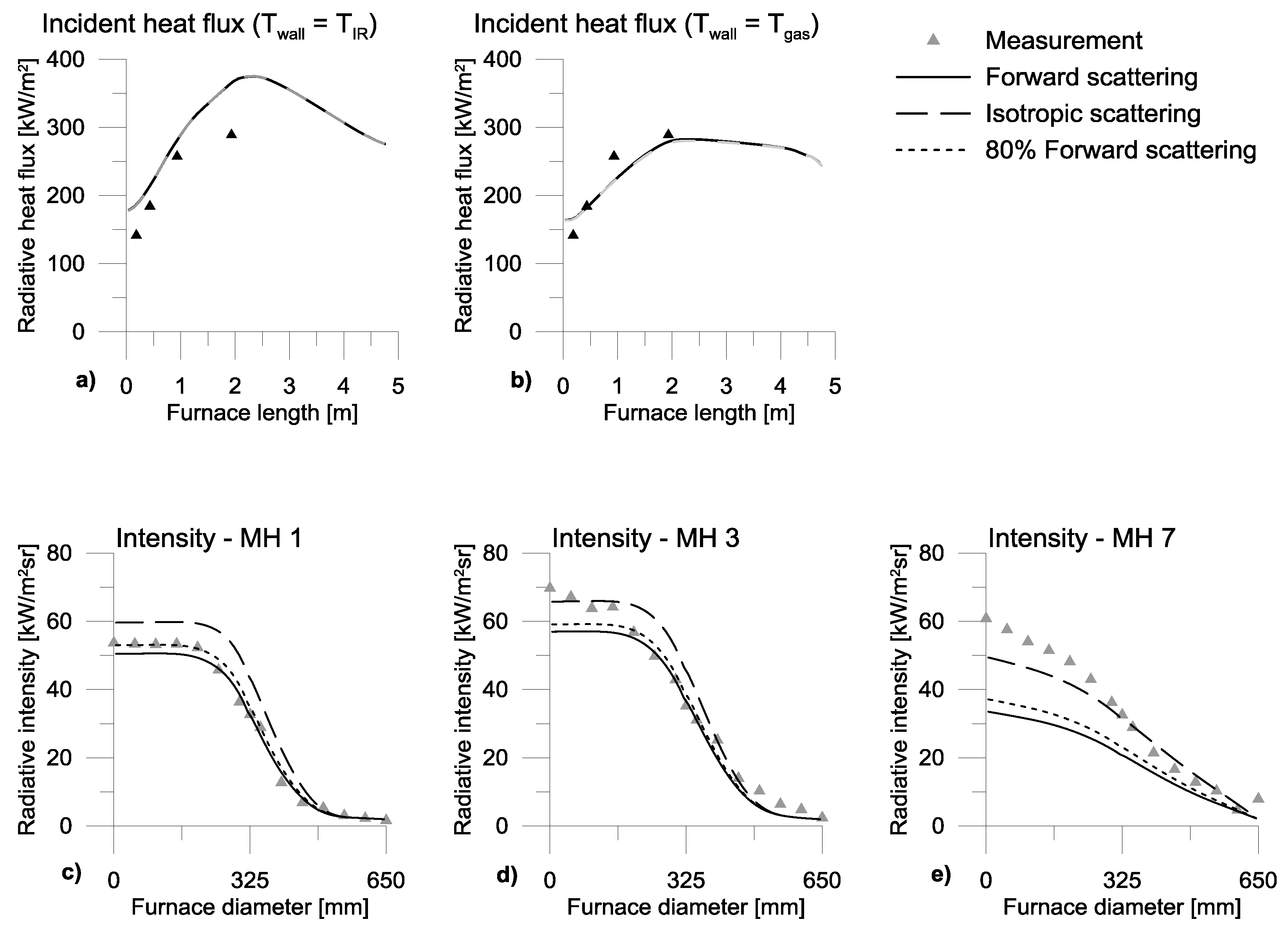

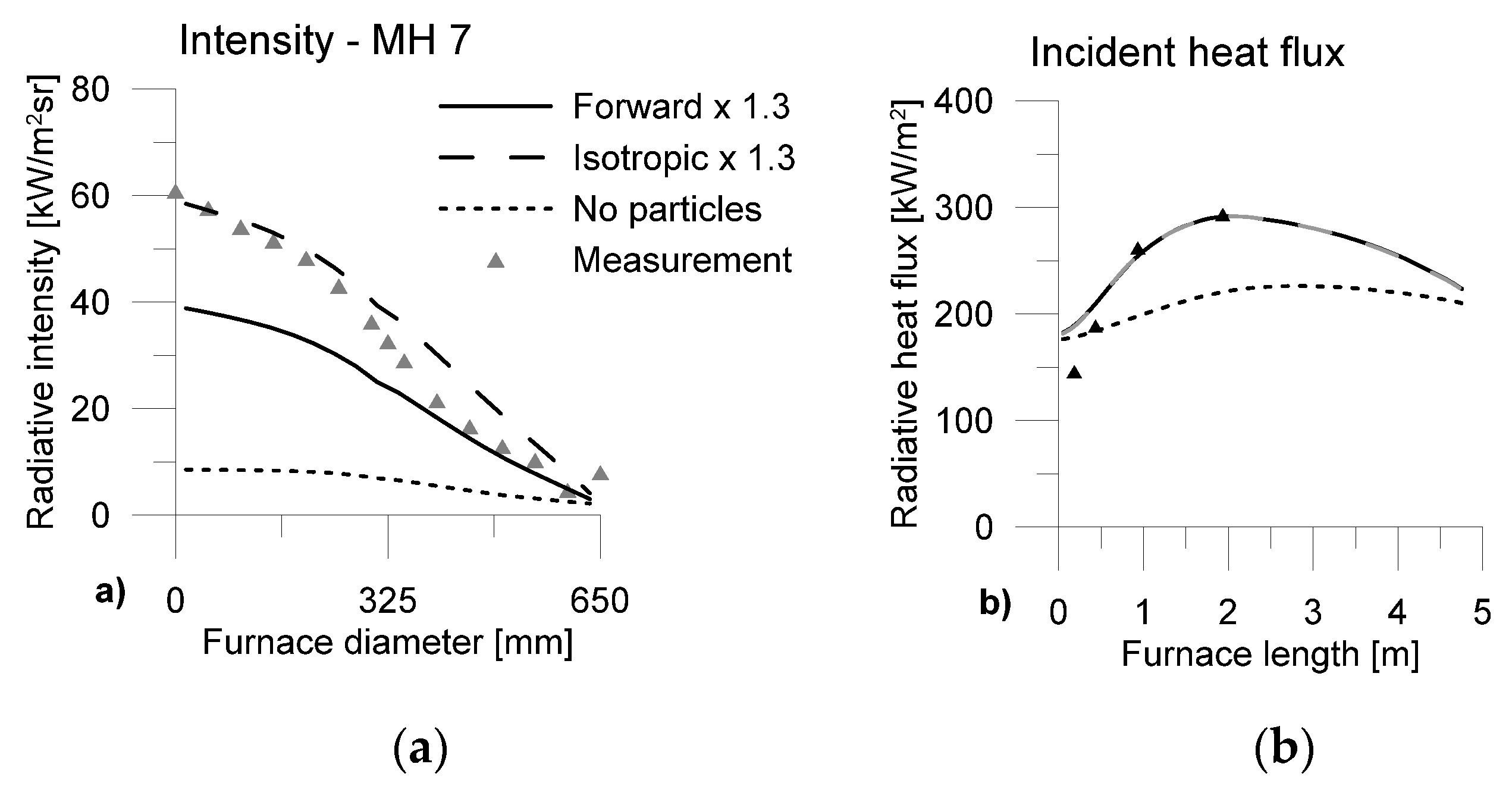
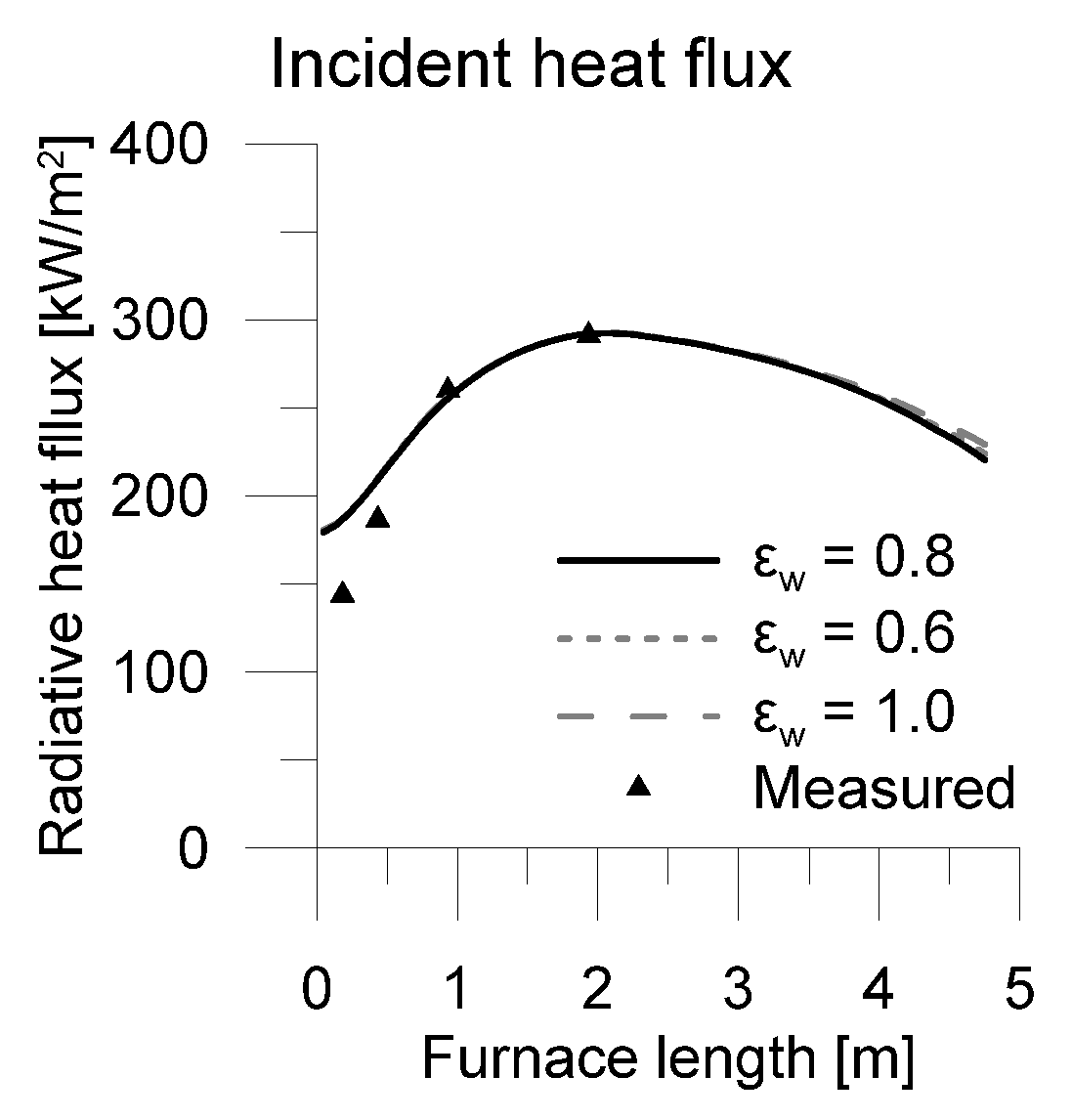
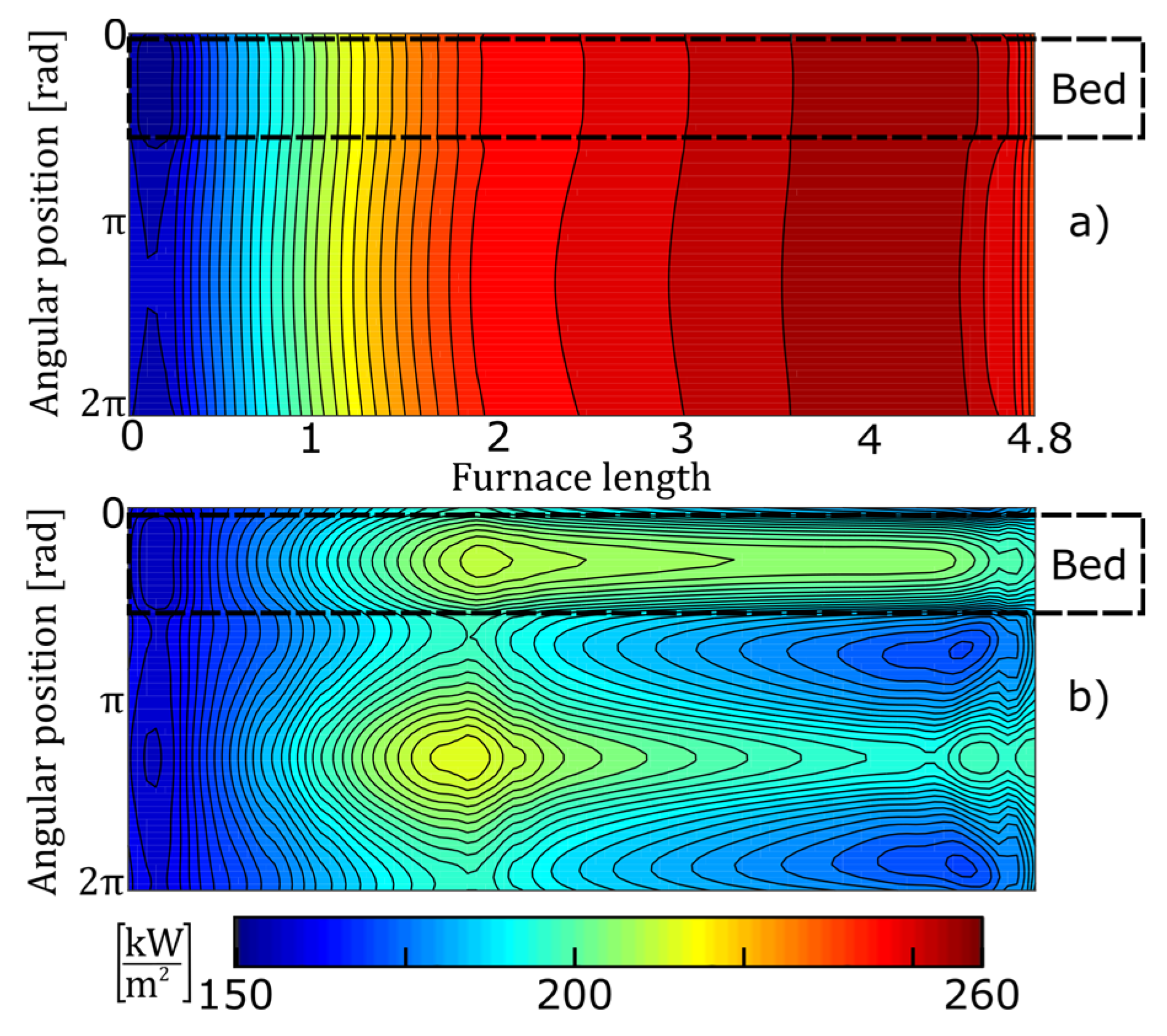
| 0.1422555 | 0.1422555 | 0.9795543 | 0.1712359 |
| 0.1422555 | 0.5773503 | 0.8040087 | 0.0992284 |
| 0.1422555 | 0.8040087 | 0.5773503 | 0.0992284 |
| 0.1422555 | 0.9795543 | 0.1422555 | 0.1712359 |
| 0.5773503 | 0.1422555 | 0.8040087 | 0.0992284 |
| 0.5773503 | 0.5773503 | 0.5773503 | 0.4617179 |
| 0.5773503 | 0.8040087 | 0.1422555 | 0.0992284 |
| 0.8040087 | 0.1422555 | 0.5773503 | 0.0992284 |
| 0.8040087 | 0.5773503 | 0.1422555 | 0.0992284 |
| 0.9795543 | 0.1422555 | 0.1422555 | 0.1712359 |
© 2020 by the authors. Licensee MDPI, Basel, Switzerland. This article is an open access article distributed under the terms and conditions of the Creative Commons Attribution (CC BY) license (http://creativecommons.org/licenses/by/4.0/).
Share and Cite
Gunnarsson, A.; Andersson, K.; Adams, B.R.; Fredriksson, C. Discrete-Ordinates Modelling of the Radiative Heat Transfer in a Pilot-Scale Rotary Kiln. Energies 2020, 13, 2192. https://doi.org/10.3390/en13092192
Gunnarsson A, Andersson K, Adams BR, Fredriksson C. Discrete-Ordinates Modelling of the Radiative Heat Transfer in a Pilot-Scale Rotary Kiln. Energies. 2020; 13(9):2192. https://doi.org/10.3390/en13092192
Chicago/Turabian StyleGunnarsson, Adrian, Klas Andersson, Bradley R. Adams, and Christian Fredriksson. 2020. "Discrete-Ordinates Modelling of the Radiative Heat Transfer in a Pilot-Scale Rotary Kiln" Energies 13, no. 9: 2192. https://doi.org/10.3390/en13092192
APA StyleGunnarsson, A., Andersson, K., Adams, B. R., & Fredriksson, C. (2020). Discrete-Ordinates Modelling of the Radiative Heat Transfer in a Pilot-Scale Rotary Kiln. Energies, 13(9), 2192. https://doi.org/10.3390/en13092192





